Nokia Solutions and Networks WTPA-01 GSM 1900 Transceiver User Manual dn9913471x3x0xen
Nokia Solutions and Networks GSM 1900 Transceiver dn9913471x3x0xen
Contents
Requirements for Installation

Nokia MetroSite EDGE Base Station
DN9913471 © Nokia Corporation Draft 1 (44)
Issue 3-0 en Nokia Proprietary and Confidential
Requirements for Installation and
Operation

Requirements for Installation and Operation
2 (44) © Nokia Corporation Draft DN9913471
Nokia Proprietary and Confidential Issue 3-0 en
The information in this documentation is subject to change without notice and describes only
the product defined in the introduction of this documentation. This documentation is intended
for the use of Nokia's customers only for the purposes of the agreement under which the
documentation is submitted, and no part of it may be reproduced or transmitted in any form or
means without the prior written permission of Nokia. The documentation has been prepared to
be used by professional and properly trained personnel, and the customer assumes full
responsibility when using it. Nokia welcomes customer comments as part of the process of
continuous development and improvement of the documentation.
The information or statements given in this documentation concerning the suitability, capacity,
or performance of the mentioned hardware or software products cannot be considered binding
but shall be defined in the agreement made between Nokia and the customer. However, Nokia
has made all reasonable efforts to ensure that the instructions contained in the documentation
are adequate and free of material errors and omissions. Nokia will, if necessary, explain issues
which may not be covered by the documentation.
Nokia's liability for any errors in the documentation is limited to the documentary correction of
errors. NOKIA WILL NOT BE RESPONSIBLE IN ANY EVENT FOR ERRORS IN THIS
DOCUMENTATION OR FOR ANY DAMAGES, INCIDENTAL OR CONSEQUENTIAL
(INCLUDING MONETARY LOSSES), that might arise from the use of this documentation or
the information in it.
This documentation and the product it describes are considered protected by copyright
according to the applicable laws.
NOKIA logo is a registered trademark of Nokia Corporation.
Other product names mentioned in this documentation may be trademarks of their respective
companies, and they are mentioned for identification purposes only.
Copyright © Nokia Corporation 2002. All rights reserved.

DN9913471 © Nokia Corporation Draft 3 (44)
Issue 3-0 en Nokia Proprietary and Confidential
Hereby, Nokia Corporation, declares that this product is in compliance with the
essential requirements and other relevant provisions of Directive: 1999/5/EC.
The product is marked with the CE marking and Notified Body number according to the
Directive 1999/5/EC
FCC FCC §15.21 - Information to user - This product is used as an intentional radiated
equipment and any changes or modifications on the equipment without any approval
by Nokia could void the user's authority to operate the equipment.
FCC §15.105 - Information to user - This equipment has been tested and found to
comply with the limits for a Class B digital device, pursuant to part 15 of the FCC
Rules. These limits are designed to provide reasonable protection against harmful
interference in a residential installation. This equipment generates, uses and can
radiate radio frequency energy and, if not installed and used in accordance with the
instructions, may cause harmful interference to radio communications. However, there
is no guarantee that interference will not occur in a particular installation. If this
equipment does cause harmful interference to radio or television reception, which can
be determined by turning the equipment off and on, the user is encouraged to try to
correct the interference by one or more of the following measures:
• Reorient or relocate the receiving antenna.
• Increase the separation between the equipment and receiver.
• Connect the equipment into an outlet on a circuit different from that to which the
receiver is connected.
• Consult the dealer or an experienced radio/TV technician for help.
0523

Requirements for Installation and Operation
4 (44) © Nokia Corporation Draft DN9913471
Nokia Proprietary and Confidential Issue 3-0 en

DN9913471 © Nokia Corporation Draft 5 (44)
Issue 3-0 en Nokia Proprietary and Confidential
Contents
Contents 5
List of tables 6
List of figures 7
1 About this document 11
2 Environment 13
2.1 Storage 13
2.1.1 International standard for storage 13
2.1.2 Climatic conditions for storage 13
2.1.3 Mechanical conditions for storage 14
2.2 Transportation 15
2.2.1 International standard for transportation 15
2.2.2 Climatic conditions for transportation 15
2.2.3 Mechanical conditions for transportation 17
2.3 Operation 17
2.3.1 International standard for operation 17
2.3.2 Climatic conditions for operation 17
2.3.3 Mechanical conditions for operation 19
2.3.4 Ingress protection 19
2.3.5 Acoustic noise 19
2.3.6 EMC shielding 19
2.3.7 Safety 19
3 Installation requirements 21
3.1 Checking the site 21
3.2 Space requirements 21
3.2.1 Nokia MetroSite Base Station dimensions and weight 22
3.2.2 Clearances around BTS 22
3.3 Mounting locations and positions 24
3.4 Requirements for wall and pole installation 26
3.5 Grounding 27
3.6 Mains power 28
3.6.1 Power consumption 28
3.6.2 Acoustic sound power 30
3.6.3 Connectors, cables, and fuses for cable protection 31
3.7 Painting the BTS cover 32
4 Cabinet interfaces and cables 37
4.1 Cable entry block 38
5 Installation equipment 41
Index 43

Requirements for Installation and Operation
6 (44) © Nokia Corporation Draft DN9913471
Nokia Proprietary and Confidential Issue 3-0 en
List of tables
Table 1. Permitted climatic conditions for storage 14
Table 2. Climatic conditions for transportation 16
Table 3. Climatic conditions for operation (class 4.1, extended) 18
Table 4. Wind loads and pole strength requirements 26
Table 5. Permitted operating voltage fluctuation 28
Table 6. Connectors, cables and recommended fuses 32
Table 7. MetroSite BTS connectors 37
Table 8. Transmission connectors of the Nokia MetroSite EDGE Base Station 38

DN9913471 © Nokia Corporation Draft 7 (44)
Issue 3-0 en Nokia Proprietary and Confidential
List of figures
Figure 1. Dimensions of the Nokia MetroSite EDGE Base Station cabinet 22
Figure 2. Clearances around Nokia MetroSite EDGE Base Station 23
Figure 3. Mounting of the Nokia MetroSite EDGE Base Station 25
Figure 4. Power consumption of the Nokia MetroSite EDGE Base Station 29
Figure 5. Range of acoustic sound power generated by Nokia MetroSite EDGE
Base Station 30
Figure 6. Removing the top of the BTS cover 33
Figure 7. Areas used for holding the cable cover parts during painting 34
Figure 8. Cable entry block: cable diameters 39
Figure 9. Recommended tools for installing the BTS 41

Requirements for Installation and Operation
8 (44) © Nokia Corporation Draft DN9913471
Nokia Proprietary and Confidential Issue 3-0 en

DN9913471 © Nokia Corporation Draft 9 (44)
Issue 3-0 en Nokia Proprietary and Confidential
Summary of changes
Version 1-0, 12th November 1999.
Version 2-0, 22nd June 2000:
• Added GSM to the title and body text
• Added CE marking
• Added acoustic noise for 5W TRX BTS in Chapters 2.3.5, 3.6.2 and in
Figure 5
• Increased cabinet length to 870 mm in Figures 1 and 2
• Added horizontal mounting note in Chapter 3.3 and edited Figure 3
• Corrected ground resistance figure in Chapter 3.5
• Added note on dark colours in Chapter 3.7
Version 3-0, 17th May 2001:
• Updated for EDGE
Version 3-1, July 2002
• ETS 300 019 1-2:1992 class 2.2 upgraded to class 2.3 following vibration
test results
• Note added about horizontal mounting not being suitable for BTSs with the
WCUA cover

Requirements for Installation and Operation
10 (44) © Nokia Corporation Draft DN9913471
Nokia Proprietary and Confidential Issue 3-0 en

About this document
DN9913471 © Nokia Corporation Draft 11 (44)
Issue 3-0 en Nokia Proprietary and Confidential
1About this document
This document introduces the requirements set by the Nokia MetroSite EDGE
Base Station for successful installation and operation. Use this document as the
source for the following information needed in the planning of an installation:
• specification on the environmental conditions during transportation,
storage and operation
• space requirements and other site-related installation matters
• site grounding and power supply to the BTS
• interface connections
• installation tools
Read also Nokia MetroSite EDGE Base Station: Warnings and Cautions in
conjunction with this document.

Requirements for Installation and Operation
12 (44) © Nokia Corporation Draft DN9913471
Nokia Proprietary and Confidential Issue 3-0 en

Environment
DN9913471 © Nokia Corporation Draft 13 (44)
Issue 3-0 en Nokia Proprietary and Confidential
Caution
2Environment
This chapter defines the classes of environmental conditions and the severities to
which the Nokia MetroSite EDGE Base Station can be exposed. The information
is organised into the conditions for: storage, transportation, and operation.
2.1 Storage
This section defines the environmental conditions to which the Nokia MetroSite
EDGE Base Station can be exposed to during storage.
The Nokia MetroSite EDGE Base Station must be stored in its original package
before the installation.
2.1.1 International standard for storage
According to the standard ETS 300 019-1-1:1992, the storage class for the Nokia
MetroSite EDGE Base Station is class 1.2: weather-protected, partly temperature-
controlled storage locations.
2.1.2 Climatic conditions for storage
The possible climatic conditions under which the Nokia MetroSite EDGE Base
Station can be stored are presented in Table 1 (according to ETS 300 019-1-
1:1992).

Requirements for Installation and Operation
14 (44) © Nokia Corporation Draft DN9913471
Nokia Proprietary and Confidential Issue 3-0 en
2.1.3 Mechanical conditions for storage
The Nokia MetroSite EDGE Base Station complies with the standard ETS 300
019-1-1:1992 class 1.2.
Table 1. Permitted climatic conditions for storage
Environmental parameter Value
Low air temperature - 25°C
- 13°F
High air temperature + 55°C
+ 131°F
Low relative humidity 10%
High relative humidity 100%
Low absolute humidity 0.5 g/m3
High absolute humidity 29 g/m3
Rain intensity none
Temperature change rate (average of 5
minutes)
0.5°C/min
0.9°F/min
Low air pressure 70 kPa
10.15 psi
High air pressure 106 kPa
15.37 psi
Solar radiation 1120 W/m2
Surrounding air movement 30 m/s
98 ft/s
Conditions of condensation yes
Conditions of precipitation (rain, snow, hail,
etc.)
yes
Low rain temperature none
Conditions of water from sources other than
rain
dripping water
Conditions of icing and frosting yes

Environment
DN9913471 © Nokia Corporation Draft 15 (44)
Issue 3-0 en Nokia Proprietary and Confidential
Caution
Note
Note
2.2 Transportation
This section defines the environmental conditions to which the Nokia MetroSite
EDGE Base Station can be exposed during transportation.
The Nokia MetroSite EDGE Base Station must be transported in its original
package to the installation site.
The Nokia MetroSite EDGE Base Station is delivered to the customer with the
ordered plug-in units pre-installed.
2.2.1 International standard for transportation
According to the standard ETS 300 019-1-2:1992, the class for the Nokia
MetroSite EDGE Base Station equipment is class 2.3. This class applies to
transportation situations where special care is taken, such as special care with
respect to handling in low temperatures.
The typical transportation time is considered to be 30 days or less. When the total
transportation time exceeds 30 days, additional storage or packaging precautions
must be considered.
2.2.2 Climatic conditions for transportation
The climatic conditions permitted during the transportation are presented in Table
2 (according to ETS 300 019-1-2:1992).
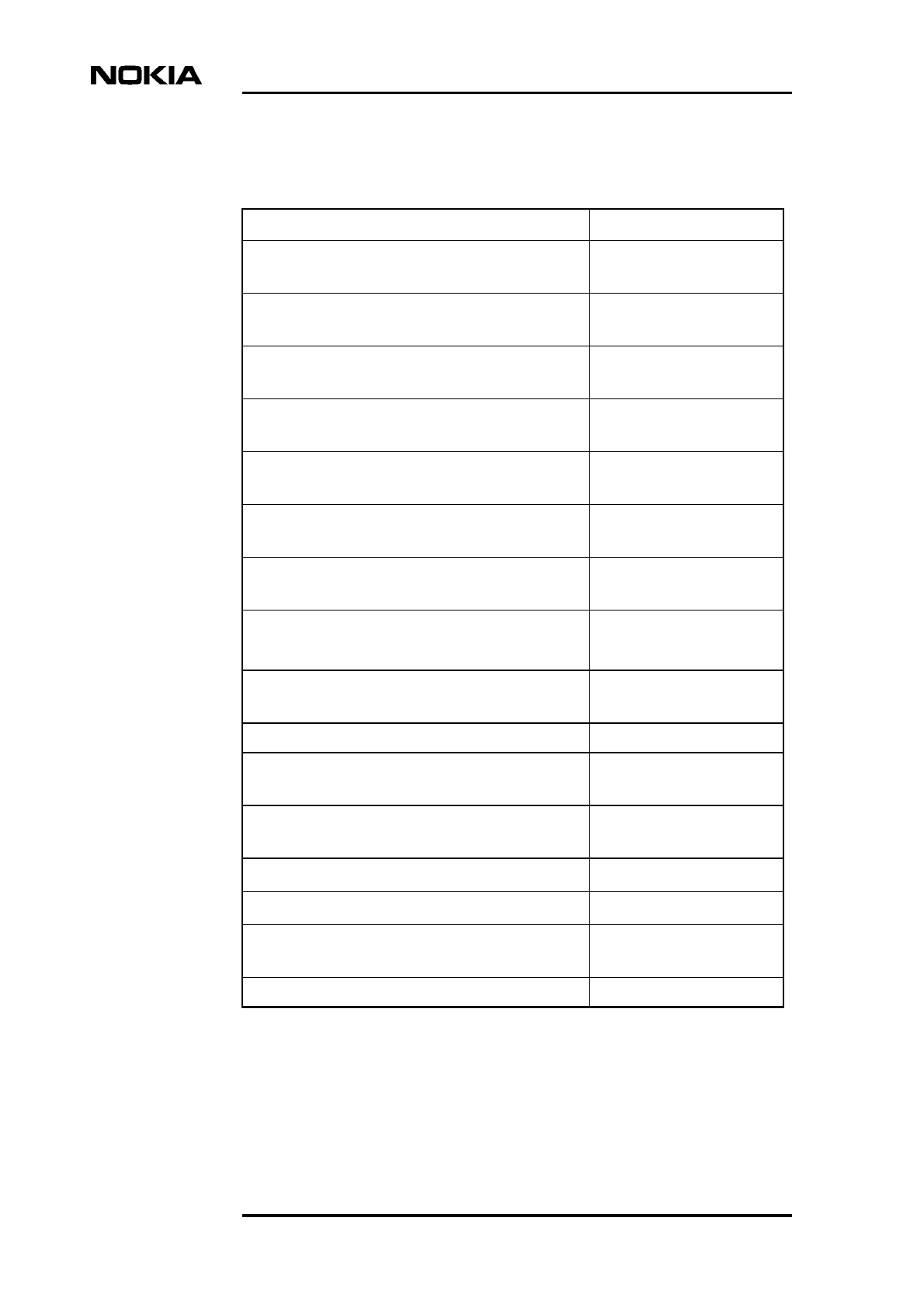
Requirements for Installation and Operation
16 (44) © Nokia Corporation Draft DN9913471
Nokia Proprietary and Confidential Issue 3-0 en
Table 2. Climatic conditions for transportation
Environmental parameter Value
Low air temperature -25°C
-13°F
High temperature, air in unventilated enclosures + 70°C
+ 158°F
High temperature, air in ventilated enclosures or
outdoor air
+ 40°C
+ 104°F
Temperature change air/air -24°C / +30°C
-11°F / +86°F
Temperature change air/water +40°C / +5°C
+104°F / +41°F
Relative humidity, not combined with rapid
temperature changes
95% +40°C
95% 104°F
Relative humidity, combined with rapid temperature
changes air/air, at high relative humidity
95% -25°C / +30°C
95% -13°F / +86°F
Absolute humidity, combined with rapid temperature
changes air/air, at high water content
60 g/m3 +70°C / +15°C
60 g/m3 +158°F / +59°F
Low air pressure 70 kPa
10.15 psi
Change of air pressure none
Surrounding air movement 20 m/s
65.6 ft/s
Precipitation, rain 6 mm/min
0.24 in/min
Radiation, solar 1120 W/m2
Radiation, heat 600 W/m2
Water from sources other than rain 1 m/s
3.28 ft/s
Wetness none

Environment
DN9913471 © Nokia Corporation Draft 17 (44)
Issue 3-0 en Nokia Proprietary and Confidential
Note
2.2.3 Mechanical conditions for transportation
In respect to mechanical conditions during transportation, the Nokia MetroSite
EDGE Base Station complies with ETS 300 019 1-2:1992 class 2.3.
2.3 Operation
This section defines the environmental conditions which are possible during the
operation of the Nokia MetroSite EDGE Base Station at locations which are not
protected from direct weather influences.
When surveying the prospective sites, consider the values presented in this
section.
Operating conditions are defined as stationary: the equipment is mounted on a
structure or mounting device, or it is permanently placed at a site. The Nokia
MetroSite EDGE Base Station is not intended for portable use.
2.3.1 International standard for operation
According to the standard ETS 300 019-1-4:1992, the class for Nokia MetroSite
EDGE Base Station equipment is class 4.1.
2.3.2 Climatic conditions for operation
In respect to climatic conditions during operation, the Nokia MetroSite EDGE
Base Station complies principally with class 4.1, as presented in Table 3.
However, for the temperature and humidity values, the table presents extended
operational climatic conditions, which differ from class 4.1. The weather
shielding of the Nokia MetroSite EDGE Base Station is valid when the BTS is
mounted in the recommended positions.

Requirements for Installation and Operation
18 (44) © Nokia Corporation Draft DN9913471
Nokia Proprietary and Confidential Issue 3-0 en
Table 3. Climatic conditions for operation (class 4.1, extended)
Environmental
parameter Class 4.1 value
Extended value for Nokia
MetroSite EDGE Base
Station
Low air temperature -33°C
-27°F
-40°C
-40°F
High air temperature +40°C
+104°F
+50°C
+122°F
Low relative humidity 15% -
High relative humidity 100% -
Low absolute humidity 0.26 g/m30.03 g/m3
High absolute humidity 25 g/m336 g/m3
Rain intensity 6 mm/min
0.24 in./min
-
Temperature change rate
(average of 5 minutes)
0.5 °C/min
0.9 °F/min
-
Low air pressure 70 kPa
10.15 psi
-
High air pressure 106 kPa
15.37 psi
-
Solar radiation 1120 W/m2-
Heat radiation insignificant -
Surrounding air movement 50 m/s
164 ft/s
-
Conditions of
condensation
yes -
Conditions of precipitation
(rain, snow, hail etc.)
yes -
Low rain temperature +5°C
+41°F
-
Conditions of water from
sources other than rain
splashing water -
Conditions of icing and
frosting
yes -

Environment
DN9913471 © Nokia Corporation Draft 19 (44)
Issue 3-0 en Nokia Proprietary and Confidential
2.3.3 Mechanical conditions for operation
In respect to mechanical conditions during operation, the Nokia MetroSite EDGE
Base Station complies with ETS 300 019-1-4:1992 class 4.1.
2.3.4 Ingress protection
The electronic components inside the units of the Nokia MetroSite EDGE Base
Station are protected against the ingress of rain, snow and dust to the minimum
level of IP55 of European standard EN 60529, and level 3R of UL standard 50.
2.3.5 Acoustic noise
The maximum acoustic noise generated by the Nokia MetroSite EDGE Base
Station is 61 dBA. The acoustic noise is measured according to ISO 3744. The
noise type is sound power.
2.3.6 EMC shielding
The chassis and the units of the Nokia MetroSite EDGE Base Station together
provide the electromagnetic compatibility (EMC) shielding. The EMC shielding
complies with the standards listed in Nokia MetroSite EDGE Base Station:
Product Description.
2.3.7 Safety
The MetroSite BTS cabinet fulfils the relevant safety requirements: EN 60215,
EN 60950 and UL 1950.
For more specific information refer to Nokia MetroSite EDGE Base Station:
Product Description.

Requirements for Installation and Operation
20 (44) © Nokia Corporation Draft DN9913471
Nokia Proprietary and Confidential Issue 3-0 en

Installation requirements
DN9913471 © Nokia Corporation Draft 21 (44)
Issue 3-0 en Nokia Proprietary and Confidential
3Installation requirements
This chapter specifies the preparatory requirements for the installation of the
Nokia MetroSite EDGE Base Station.
3.1 Checking the site
The cabinet installation phase requires that the site is properly surveyed and
prepared, and that all the required external services are correctly installed. The
site survey must identify any special requirements for the installation.
The site must meet the following requirements before an installation can be
started:
1. The site is accessible and safe for working.
2. The safety distance calculations presented in Nokia MetroSite EDGE Base
Station: Warnings and Cautions are being applied.
3. When radio link transmission is used, the rule for line-of-sight to the far
end radios is being applied.
4. The external connections for the cabinet are in place: a site grounding
point, mains power (AC or DC, according to the site) with an appropriate
disconnect device, and a transmission connection point.
5. All required documentation is available. For example, site-specific
installation instructions.
6. The correct BTS delivery package and accessories have been brought to the
site. Refer to Nokia MetroSite EDGE Base Station: Installation for details.
3.2 Space requirements
The Nokia MetroSite EDGE Base Station can be mounted on a wall or pole. This
section presents the general issues that must be considered when choosing the
installation space.
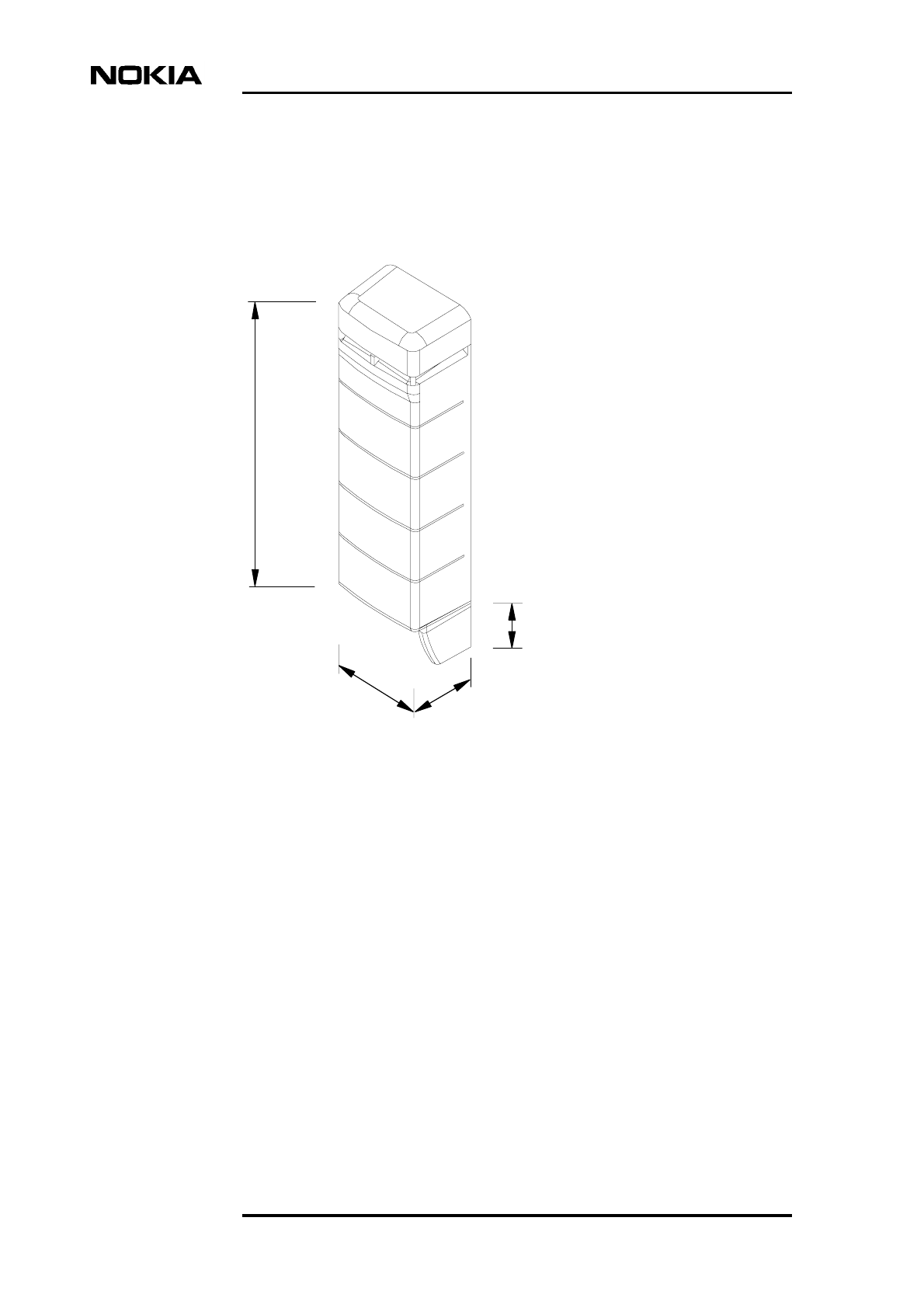
Requirements for Installation and Operation
22 (44) © Nokia Corporation Draft DN9913471
Nokia Proprietary and Confidential Issue 3-0 en
3.2.1 Nokia MetroSite Base Station dimensions and weight
Figure 1 presents the external dimensions of the Nokia MetroSite EDGE Base
Station.
Figure 1. Dimensions of the Nokia MetroSite EDGE Base Station cabinet
The Nokia MetroSite EDGE Base Station with four TRXs installed weighs
approximately 40 kg (88.4 lb). The mounting rack weighs approximately 2 kg
(4.4 lb). The dimensions and weights of the plug-in units can be found in Nokia
MetroSite EDGE Base Station: Product Description.
3.2.2 Clearances around BTS
The required clearances around the Nokia MetroSite EDGE Base Station are
shown in Figure 2.
310 mm 215 mm
114 mm
870 mm
(34.25 in)
(4.49 in)
(12.20 in) (8.46 in)
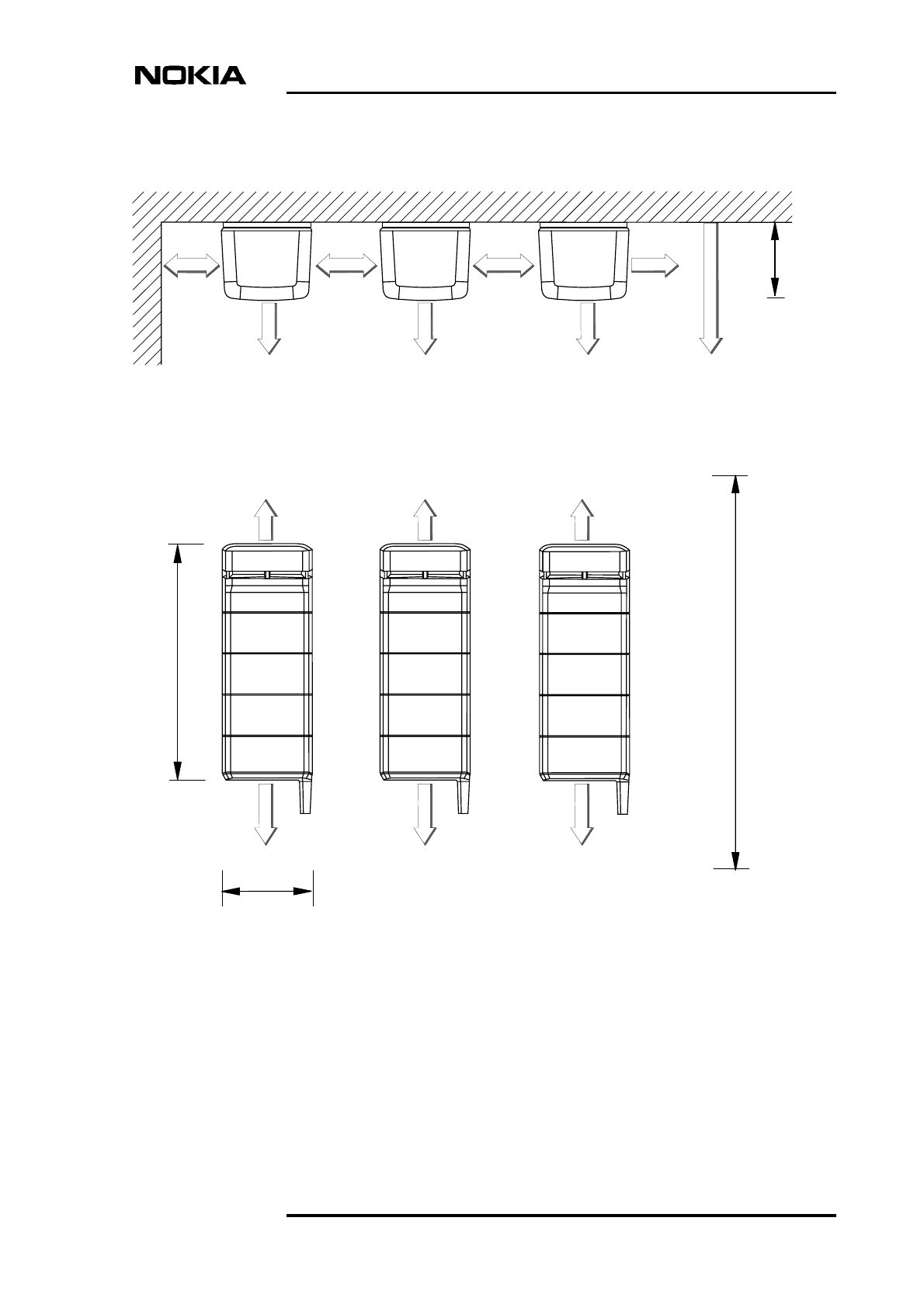
Installation requirements
DN9913471 © Nokia Corporation Draft 23 (44)
Issue 3-0 en Nokia Proprietary and Confidential
Figure 2. Clearances around Nokia MetroSite EDGE Base Station
The packing cardboard in the BTS transportation package includes a marked-out
template for defining the clearances around the BTS and for marking the drilling
holes needed for wall mounting. Use the template for defining how much space
is required:
Top view
Front view
Min
50
(2.0)
260
(10.2)
245 (9.65)
310
(
12.2
)
100 (3.94)
480
(18.9)
300 (11.9)
260
(10.2)
260
(10.2)
235
(9.3)
100 (3.94) 100 (3.94)
235
(9.3)
235
(9.3)
300 (11.9) 300 (11.9)
NOTE
:
DIMENSIONS
mm
(i
nc
h)
870mm (34,25 in)
1270mm (50 in)

Requirements for Installation and Operation
24 (44) © Nokia Corporation Draft DN9913471
Nokia Proprietary and Confidential Issue 3-0 en
Note
• to remove units from the BTS when it is installed on a wall or pole
• to remove and replace the cover when the BTS is installed on a wall or a
pole
• for cables and for cooling under the BTS
Refer to wall mounting instructions in Nokia MetroSite EDGE Base Station:
Installation for more information on using the cardboard template.
3.3 Mounting locations and positions
The Nokia MetroSite EDGE Base Station can be mounted on a wall or on a pole.
Both indoor and outdoor applications are possible. The Nokia MetroSite EDGE
Base Station can also be mounted horizontally in the position shown in Figure 3,
item B. No other horizontal positions are permitted.
The space in which the Nokia MetroSite EDGE Base Station is located must have
proper ventilation.
Horizontal mounting is not recommended for all site conditions. Nokia MetroSite
EDGE BTSs fitted with the WCUA type cover are not suitable for horizonatal
mounting. Contact your Nokia representative for more information.
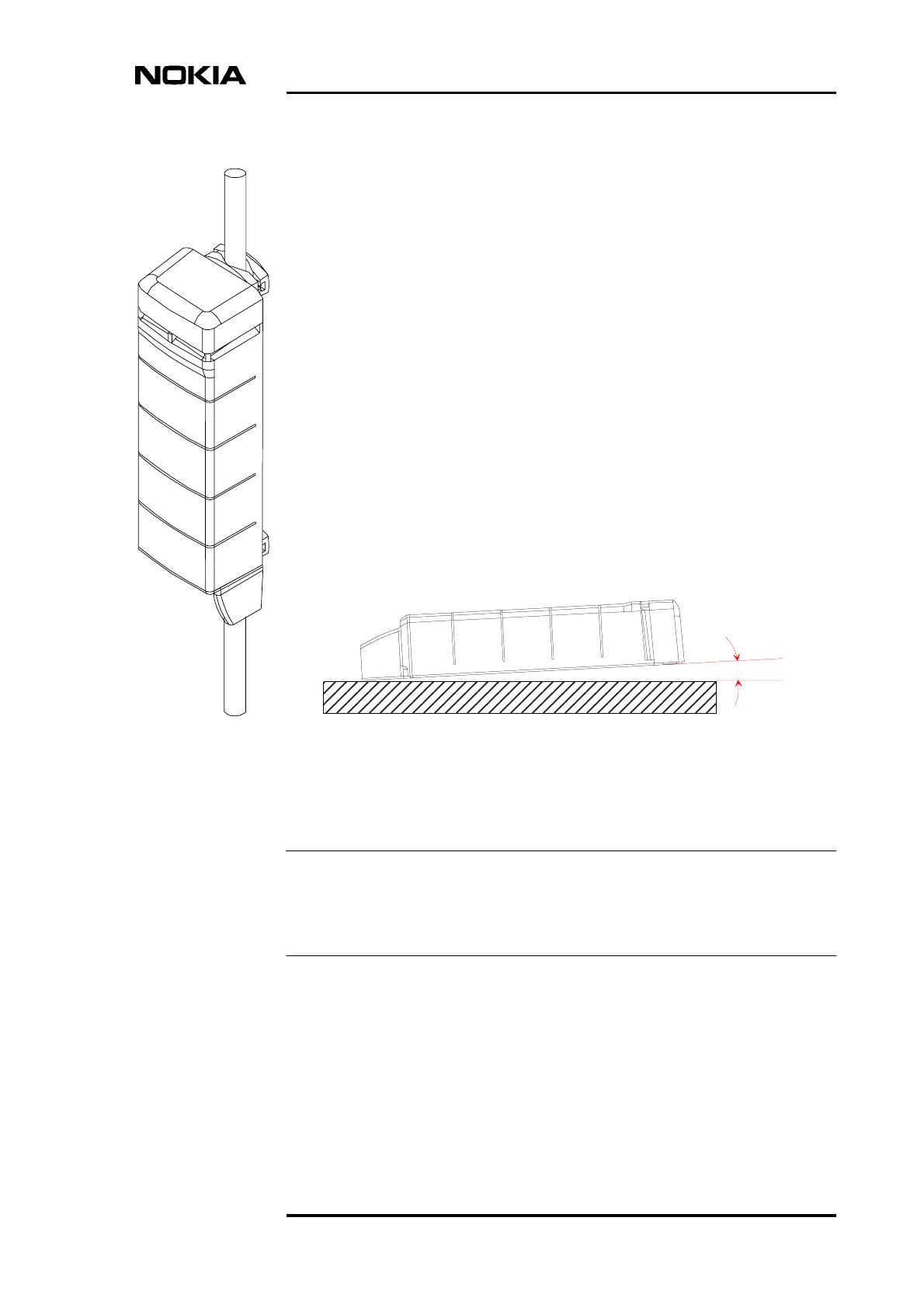
Installation requirements
DN9913471 © Nokia Corporation Draft 25 (44)
Issue 3-0 en Nokia Proprietary and Confidential
Note
Figure 3. Mounting of the Nokia MetroSite EDGE Base Station
If there is a risk that lumps of snow or pieces of ice can fall onto the BTS (from
the antenna or microwave radio pole, for example), an effective roof must be
mounted to shield the BTS.
B) Horizontal mountingA) Vertical mounting
Incline by 2 - 3 º
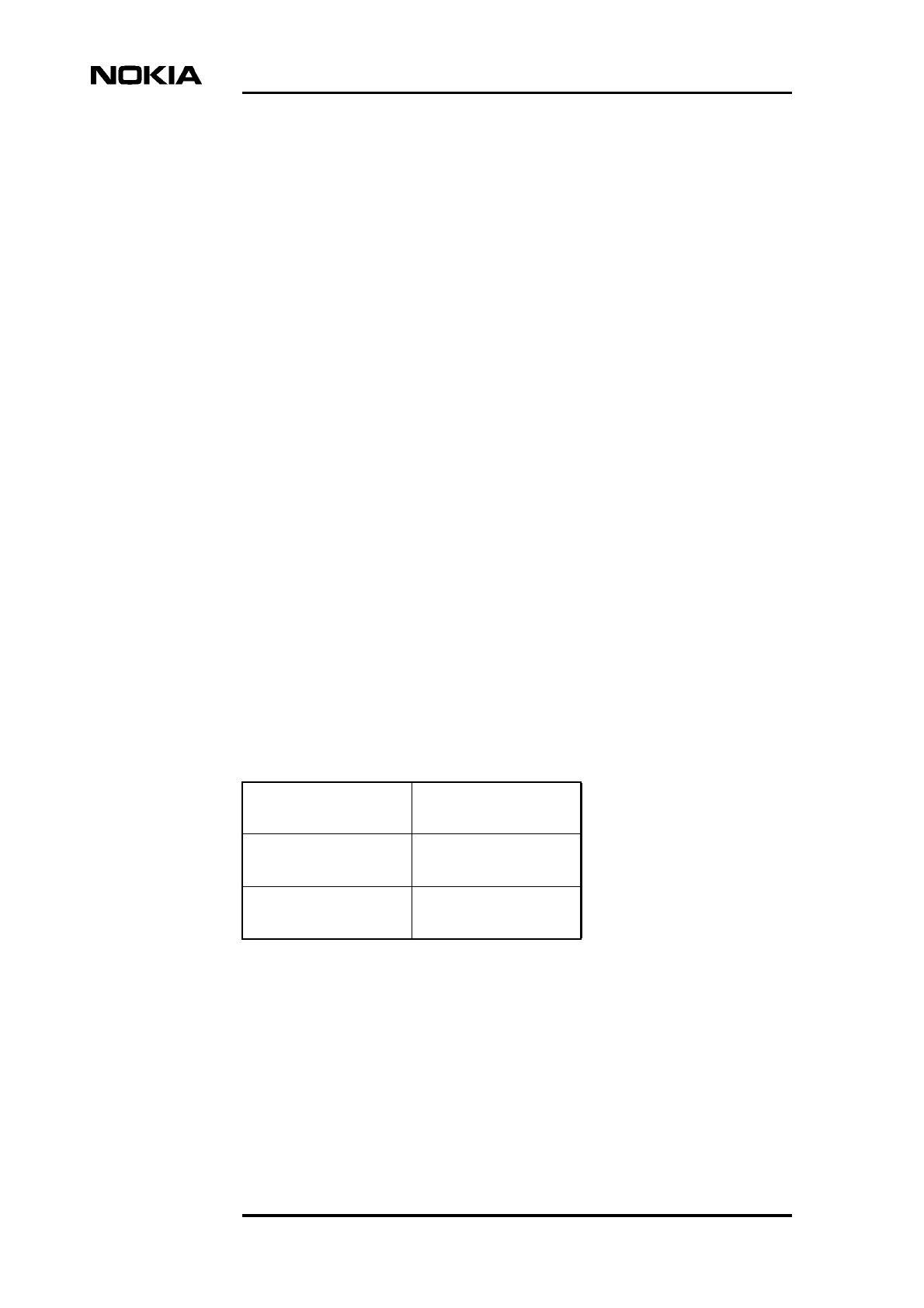
Requirements for Installation and Operation
26 (44) © Nokia Corporation Draft DN9913471
Nokia Proprietary and Confidential Issue 3-0 en
3.4 Requirements for wall and pole installation
The installation wall or pole must be inspected by qualified personnel before
mounting the BTS. This is to ensure that the mounting is strong enough to bear
the weight of the BTS (maximum 40 kg / 88.2 lb) in its operating environment.
Pole mounting kit
An optional pole mounting kit is required for pole installations. This kit is ordered
separately if required. The pole diameter can be between 60 and 300 mm (2.36
and 11.81 in.). Refer to Nokia MetroSite EDGE Base Station: Installation for
detailed information on pole mounting of the BTS.
Anchor screws
Anchor screws are used for attaching the Nokia MetroSite EDGE Base Station to
the wall. These screws are not included in the delivery.
The anchor screws must be M6 size, stainless steel, and with the minimum
breaking strength (Rm) of 800 N/mm2. An appropriate mounting counterpart for
the anchor screw (such as an anchor plug) must be selected according to the screw
and the mounting base material. If the anchor screws are of a type other than
metric, they must be selected to meet the strength requirements mentioned above.
Wind load
For pole mounting, a pole strong enough to withstand stormy conditions must be
selected. Table 4 shows the loads imposed on the pole (with a BTS attached to it)
for two possible wind velocities.
Table 4. Wind loads and pole strength requirements
Wind velocity Load imposed on
the pole
40 m/s
89 mph
410 N
50 m/s
112 mph
640 N

Installation requirements
DN9913471 © Nokia Corporation Draft 27 (44)
Issue 3-0 en Nokia Proprietary and Confidential
Note
Note
3.5 Grounding
To protect the Nokia MetroSite EDGE Base Station from damaging over voltages
through antenna equipment, communication cables, or power supply lines,
grounding cabling must be planned and installed before installation of the base
station. To avoid interference, it is recommended that large grounding systems be
designed case-specifically.
A electrical plug with a ground connection is not sufficient for the Nokia
MetroSite EDGE Base Station. Grounding must have a fixed, non-removable
connection.
Regulations issued by local authorities must be followed when planning the
grounding of a BTS site!
In general, grounding is planned according to the following requirements:
• The grounding cable is connected to the grounding point inside the BTS
cabinet.
All Nokia MetroSite EDGE Base Stations are equipped with two
grounding point alternatives: a cable clamp location and a grounding stud.
Selection is made in accordance with local regulations.
• The minimum cross-section of the grounding cable’s copper (Cu)
conductor is 16 mm2 (5 AWG) in outdoor installations. In indoor
installations, the minimum cross-section of the copper conductor is 2.5
mm2 (12 AWG).
• The maximum cross-section of the grounding cable’s copper conductor is
35 mm2 (2 AWG).
• The maximum value for ground resistance is 10 mΩ.
• The grounding cable must be connected to a main grounding bus bar.
• The routing of the grounding cable must be as direct as possible.
Unnecessary loops should be avoided.
• The external antenna feeders must also be grounded if the antennas are
exposed to the risk of lightning.
A grounding cable can be ordered from Nokia.
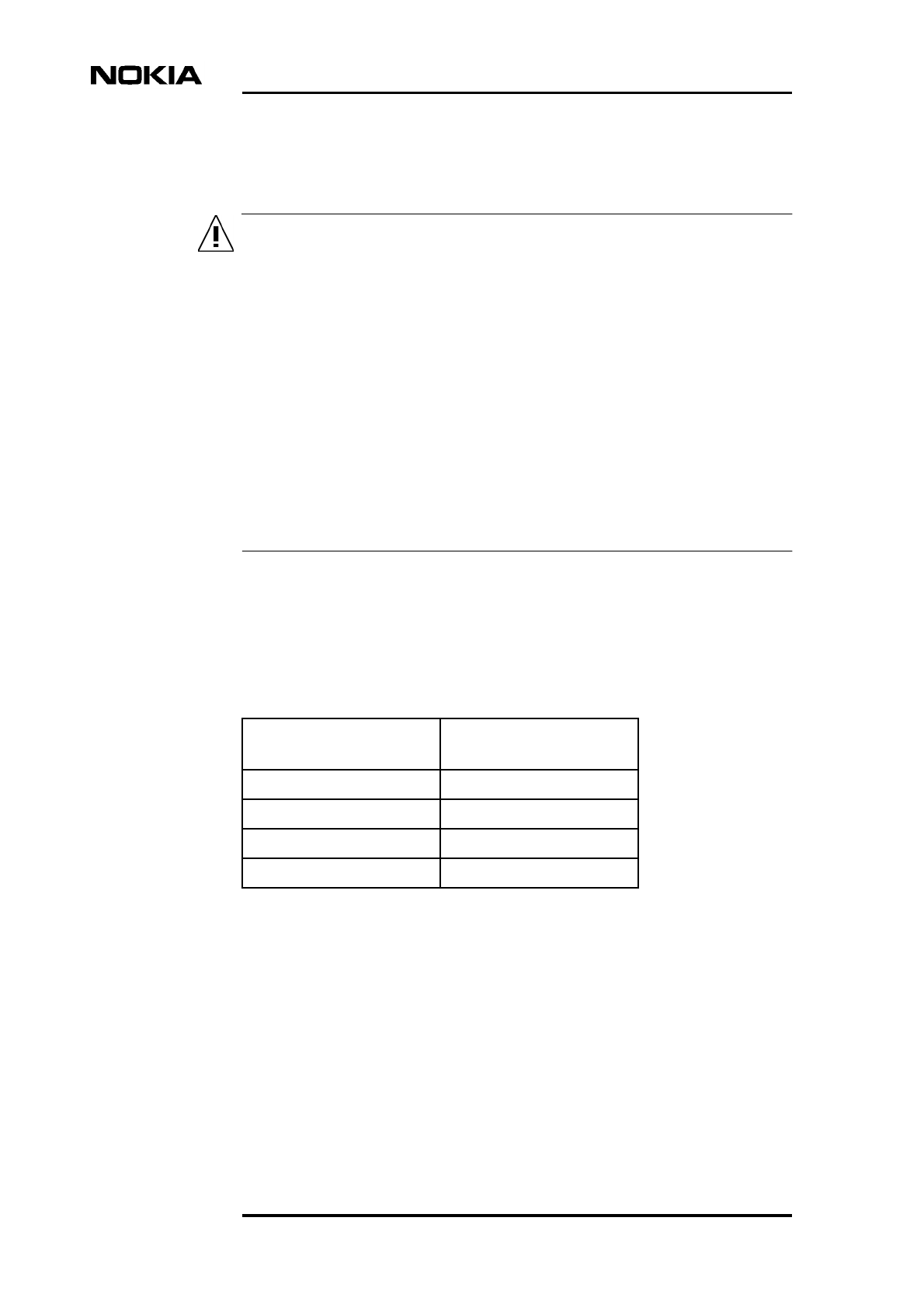
Requirements for Installation and Operation
28 (44) © Nokia Corporation Draft DN9913471
Nokia Proprietary and Confidential Issue 3-0 en
WARNING
3.6 Mains power
The power switch on the power supply unit (PSU) of the Nokia MetroSite
EDGE Base Station does not disconnect it from the power network (AC or
DC), but leaves it in a stand-by mode. The switch has two positions: ON and
stand-by. A separate main switch on the site is considered to be the
disconnect device for safety and service purposes.
Follow the national legislation when working with the power supply. The
Nokia MetroSite EDGE Base Station must be permanently wired to a
disconnect device (such as a circuit breaker) in accordance with your current
local and national wiring standards.
All ground connections must be secure and non-removable.
All power cabling must meet the requirements of the appropriate national
standard.
The Nokia MetroSite EDGE Base Station has four power supply options: 230
VAC, 110 VAC, -48 VDC and +24 VDC. The permitted voltage fluctuation for
the different options is presented in Table 5.
It is recommended that the AC mains be protected with a lightning and transient
overvoltage protector (mains wire-in protector). This protection is not included in
the Nokia MetroSite EDGE Base Station.
3.6.1 Power consumption
The power consumption of the Nokia MetroSite EDGE Base Station is dependent
on the following factors:
Table 5. Permitted operating voltage fluctuation
Nominal operating
voltage
Permitted operating
voltage fluctuation
230 VAC ±20%
110 VAC ±20%
-48 VDC +50%, -25%
+24 VDC ±20%
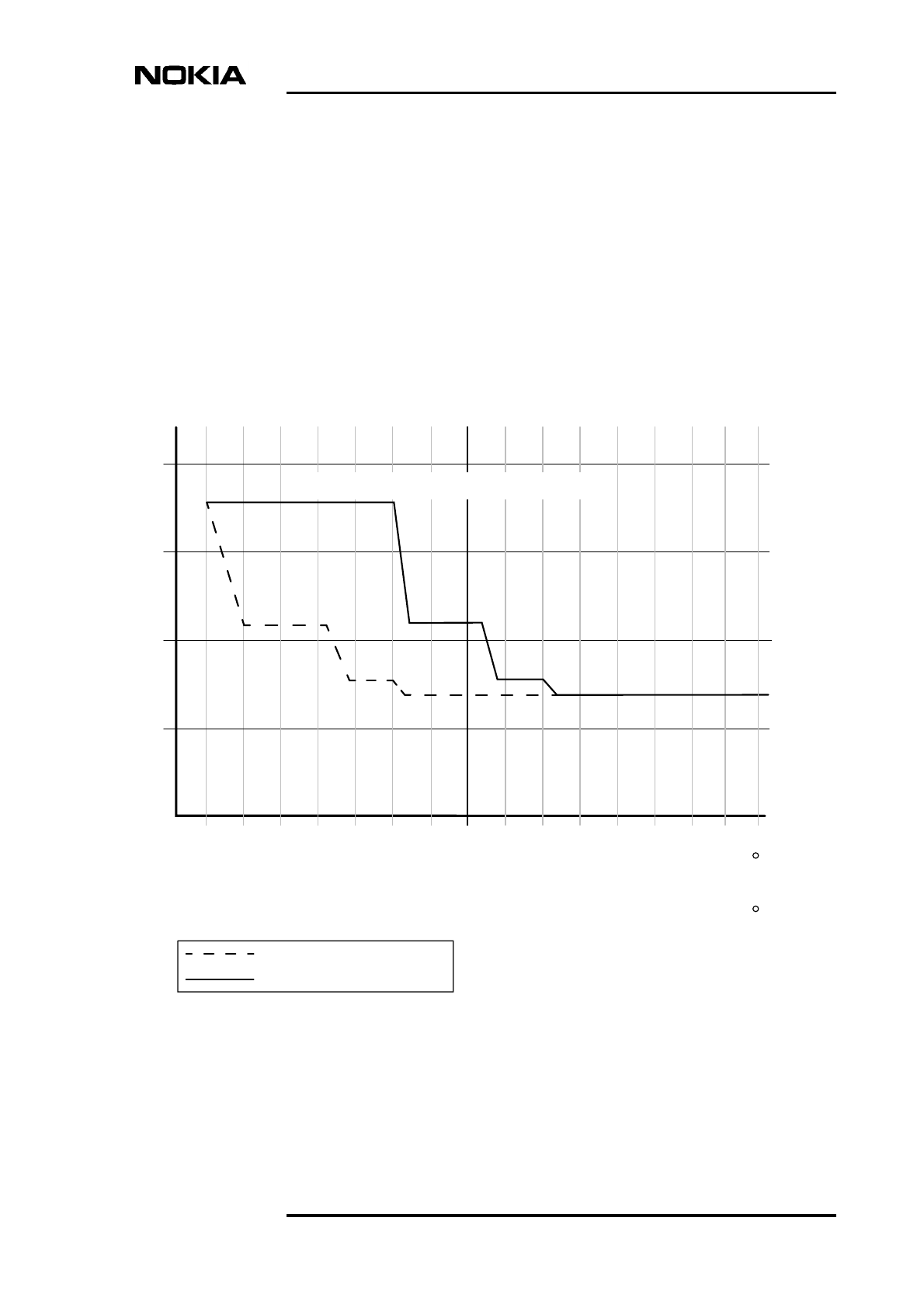
Installation requirements
DN9913471 © Nokia Corporation Draft 29 (44)
Issue 3-0 en Nokia Proprietary and Confidential
• BTS configuration
• ambient temperature
• direction of the temperature change
The power consumption is higher when the ambient temperature is decreasing
and the heating power of the BTS is increasing. When the ambient temperature
rises, the heating power reduces. Consequently, the power consumption of the
Nokia MetroSite EDGE Base Station at a given temperature varies according to
the direction of temperature change. Figure 4 presents the power consumption
values at different ambient temperatures for three BTS configurations.
Figure 4. Power consumption of the Nokia MetroSite EDGE Base Station
-40 -30
300
400
500
600
700
-20 -10 0 +10 +20 +30 +40
Power
/
W
Temperature C
Ambient temperature rising
Ambient temperature falling
-40 -22 -4 +14 +32 +50 +68 +86 +104
Temperature F
4 x 5W GSM/EDGE TRXs + 2 Flexihoppers
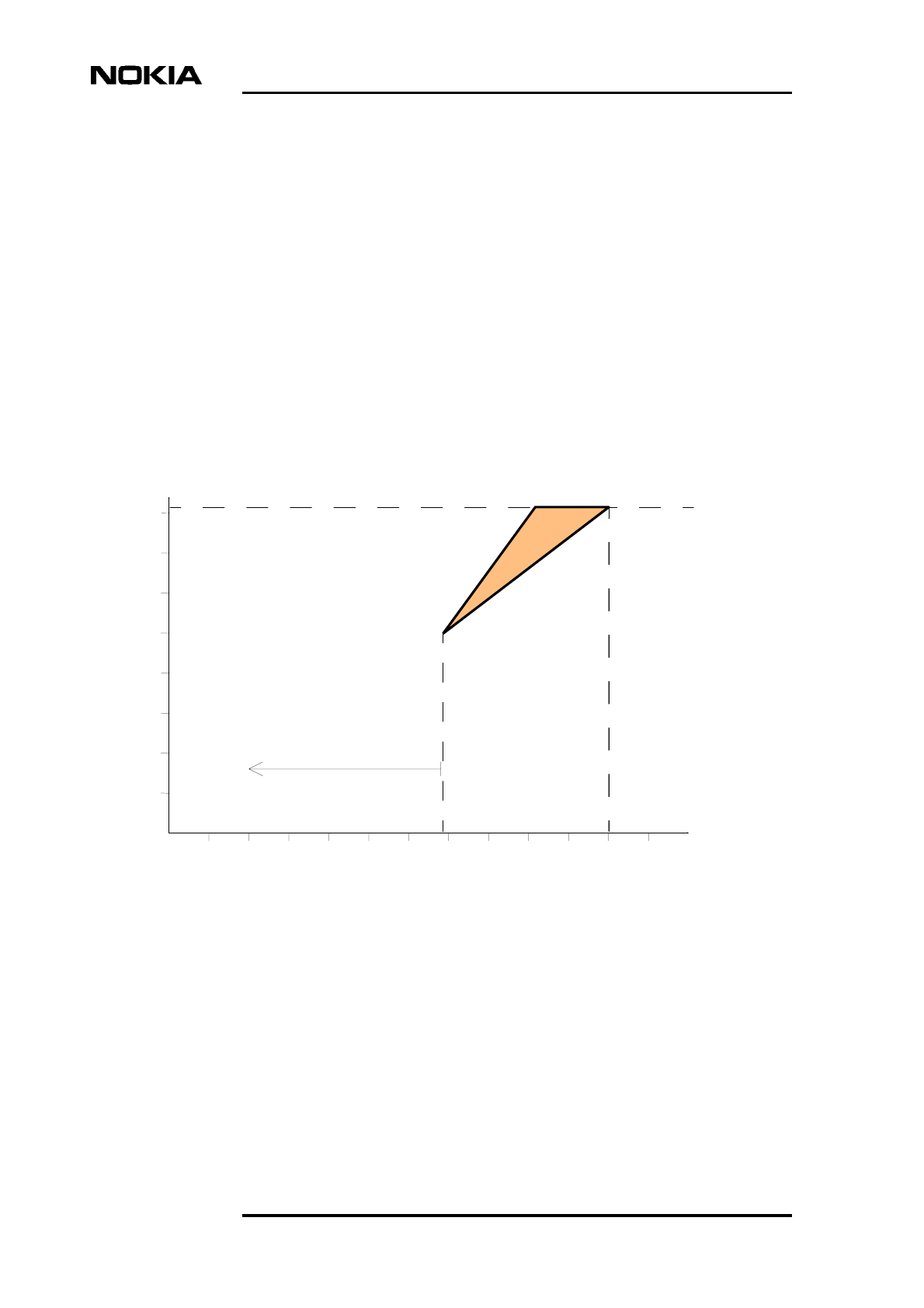
Requirements for Installation and Operation
30 (44) © Nokia Corporation Draft DN9913471
Nokia Proprietary and Confidential Issue 3-0 en
3.6.2 Acoustic sound power
The fan unit of the Nokia MetroSite EDGE Base Station generates acoustic noise.
The level of acoustic sound power is dependent on the following factors:
• ambient temperature
• rate of the temperature change
• output power
The acoustic sound power level is higher when the ambient temperature is
changing rapidly. See Figure 5 for the range of acoustic sound power levels at
different ambient temperatures.
Figure 5. Range of acoustic sound power generated by Nokia MetroSite
EDGE Base Station
TAmb
A
coust
i
c soun
d
power
30
35
40
45
50
55
Fan off
-50 -40 -30 -20 -10 0 +10 +20 +30 +40 +50 +60
o
F
+32 +68 +122
+14
-40 -22 -4 +50 +104 +140
+86
o
C
-58
60
dB(A)
5W TRX
25

Installation requirements
DN9913471 © Nokia Corporation Draft 31 (44)
Issue 3-0 en Nokia Proprietary and Confidential
Note
Note
3.6.3 Connectors, cables, and fuses for cable protection
Prefabricated mains power cables can be ordered from Nokia.
If you use the prefabricated mains power cable supplied by Nokia, make sure that
the power distribution box (mains power supply) is located no further than 10
metres from the BTS’s power supply unit.
Table 6 presents the requirements for power supply cables and the recommended
mains fuses.

Requirements for Installation and Operation
32 (44) © Nokia Corporation Draft DN9913471
Nokia Proprietary and Confidential Issue 3-0 en
Note
In general, the fuses for cable protection must be rated according to the national
electrical safety regulations.
For information on the pin configurations for the different BTS power supply
connector types, refer to Nokia MetroSite EDGE Base Station: Product
Description.
3.7 Painting the BTS cover
If desired, the BTS cover can be painted to blend into the surrounding
environment, although some dark colours with high absorptivity may be
restricted because of heat retention.
For painting the cover, Nokia recommends a primer-topcoat combination of
Beckers TD 130 primer and Beckers TH 141 surface paint. Other paints suitable
for polycarbonate surfaces may also be used.
Table 6. Connectors, cables and recommended fuses
Power
supply
type
Connector
type at the
end of cable
Cable
Recommended
fuse for cable
protection
AC supply
230 V
IEC 320
(female)
Multicore cable 3 x 0.75 to
1.5 mm2 (181/2 to 151/2
AWG)
10A for 1.5 mm2(151/2
AWG)
6A for 0.75 mm2(181/2
AWG)
AC supply
110 V
IEC 320
(female) with
notch
Multicore cable 3 x 1.5
mm2 (151/2 AWG)
10 A
DC supply -
48 V
Anderson
Power Pole
Multicore cable 3 x 2.5
mm2 or 3 single wires 2.5
to 4.0 mm2 (13 to 11
AWG)
No recommendation,
refer to local
regulations
DC supply
+24 V
Anderson
Power Pole
Multicore cable 3 x 2.5
mm2 or 3 single wires 2.5
to 4.0 mm2 (13 to 11
AWG)
No recommendation,
refer to local
regulations
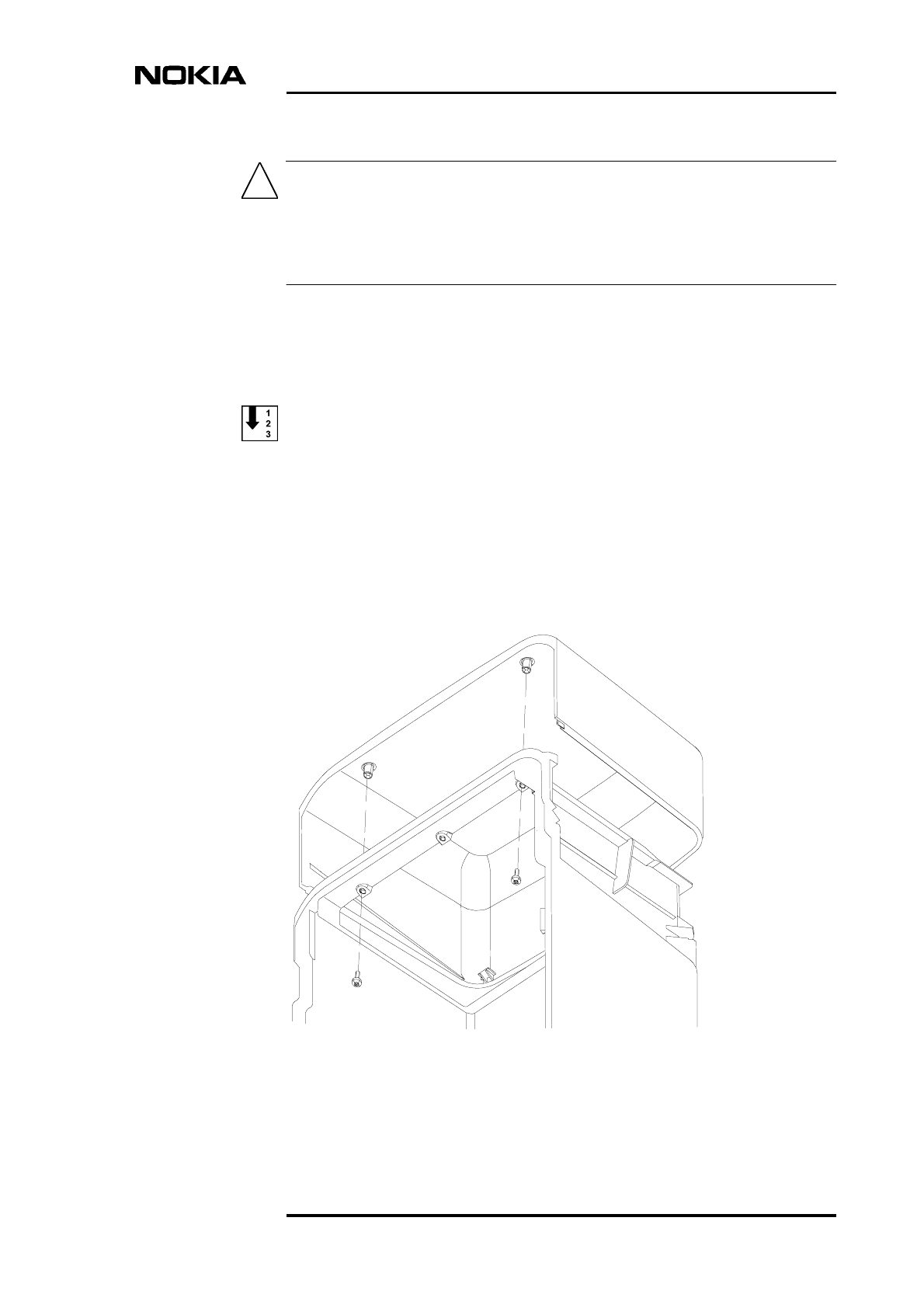
Installation requirements
DN9913471 © Nokia Corporation Draft 33 (44)
Issue 3-0 en Nokia Proprietary and Confidential
Caution
Do not use any paints that contains alkalis, esters, ketones, or aromatic,
chlorinated, or fluorinated hydrocarbons. These chemicals may damage the cover
and paint containing them can only be used if approved by the manufacturer for
painting polycarbonate objects.
The selected paint must be UV and weather resistant, and suitable for
temperatures ranging from -40°C to +50°C (-40°F to 122°F). For environmental
conditions, refer to ETS 300 019-1-4:1992 class 4.1.
Painting the BTS cover
1. Remove the BTS cover as instructed in Nokia MetroSite EDGE Base
Station: Maintenance.
2. Before painting, detach the cable cover and remove the cable cover
support. The cover top can also be detached from the cover by unscrewing
the Torx T20 screws (see Figure 6).
Figure 6. Removing the top of the BTS cover
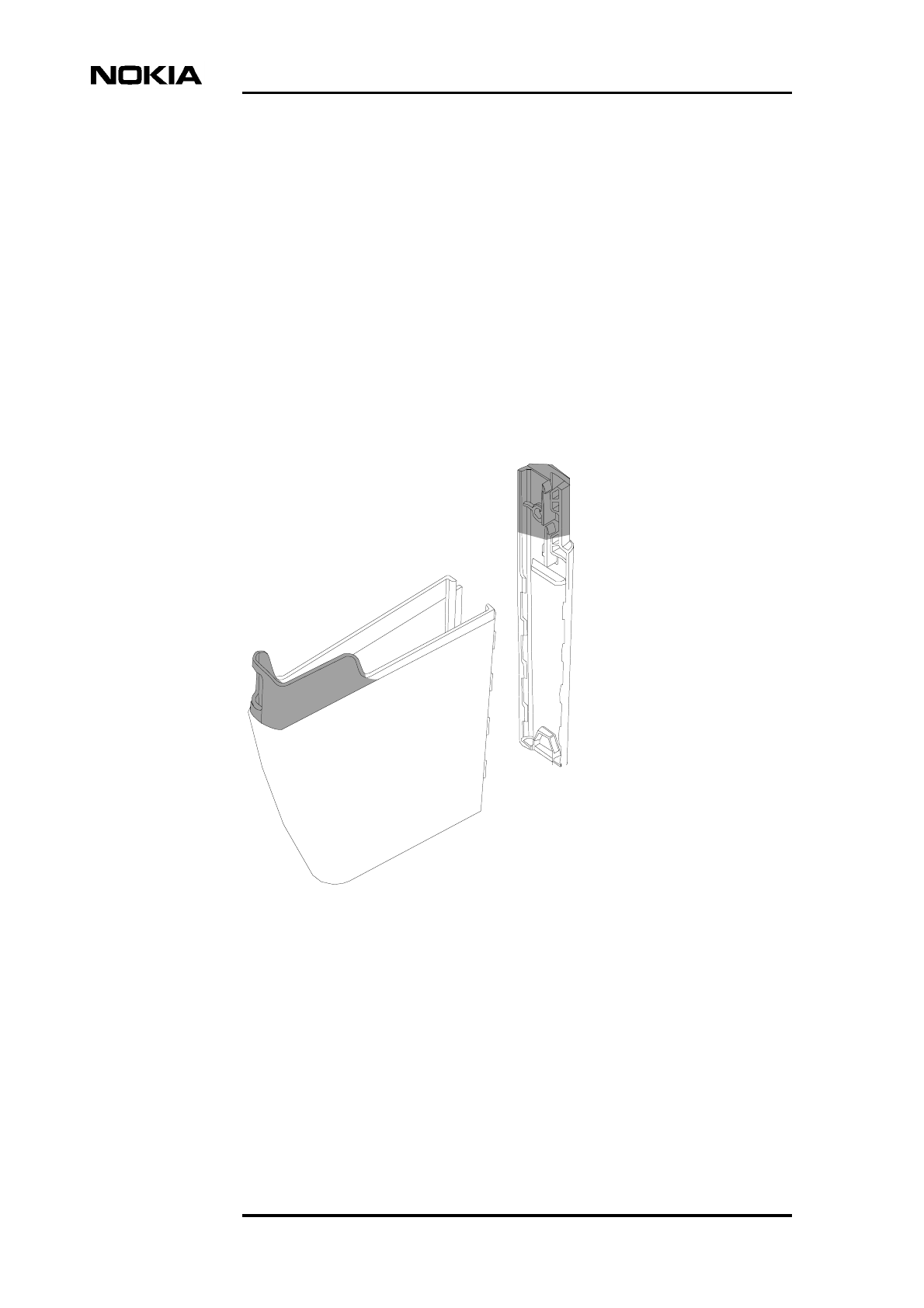
Requirements for Installation and Operation
34 (44) © Nokia Corporation Draft DN9913471
Nokia Proprietary and Confidential Issue 3-0 en
3. Remove any stains and dust from the surface of the cover with an alcoholic
or acidic wash, or with water and a mild washing agent. Do not use washing
agents that contain alkalis, esters, ketones, or aromatic, chlorinated, or
fluorinated hydrocarbons.
4. Rinse with water to remove any residue of cleaning chemicals.
5. Dry the cover parts by blowing ionized air on them to remove electrostatic
charges and dust particles.
6. Place a support under the cover and the cover top so that you do not have
to touch the parts during painting.
7. Use a clamp or hook for holding the cable cover and the cable cover
support during painting. See Figure 7 for areas on which to place the clamp.
Figure 7. Areas used for holding the cable cover parts during painting

Installation requirements
DN9913471 © Nokia Corporation Draft 35 (44)
Issue 3-0 en Nokia Proprietary and Confidential
Note
Note
8. Spray paint over the outside surface of the cover. Spraying should be done
at room temperature with relative air humidity of 50-65%.
The maximum thickness of the paint should not exceed 100 µm.
9. Dry the parts either in an oven or let the paint dry at room temperature
according to the paint manufacturer’s drying instructions.
The temperature of the drying oven must not exceed 90°C (194°F).
10. When the paint is dry, attach the cover top to the cover. Tighten the screws
to 1.6 Nm (1.18 lb ft).

Requirements for Installation and Operation
36 (44) © Nokia Corporation Draft DN9913471
Nokia Proprietary and Confidential Issue 3-0 en

Cabinet interfaces and cables
DN9913471 © Nokia Corporation Draft 37 (44)
Issue 3-0 en Nokia Proprietary and Confidential
Note
4Cabinet interfaces and cables
This chapter describes the external interfaces and interconnecting cables
(excluding the grounding and power supply cables) for the Nokia MetroSite
EDGE Base Station. For information on the pin configurations of the relevant
connectors, refer to Nokia MetroSite EDGE Base Station: Product Description.
Antenna line cables, the LMP cable, Abis cables and Flexbus cables can be
ordered from Nokia.
The MetroSite BTS interface connectors and cables are described in Tables 7 and
8.
Table 7. MetroSite BTS connectors
Interface
connector
Number of
connectors
Connector
type Cable type/diameter
Antenna
connector
1 for each TRX N-type 1/4” or 3/8” RF cable
External
Alarms and
Controls
1 (10 alarm
inputs, 4 control
outputs)
26-pin mini D
(female)
13-pair 28 AWG, 106 Ω
Flexible SCSI-2 Cable type
CL2/FT1
Extension
connectors
2 50-pin mini D
(female)
N/A
Q1 interface 1 TQ 2-pair telecom cable, max. 6
mm
Local
Management
Port
1 BQ, RS- 232 (at
the BTS end)
D9 female (at
the PC end)
2-pair telecom cable. For
more information, refer to
Nokia MetroSite EDGE Base
Station: Commissioning.
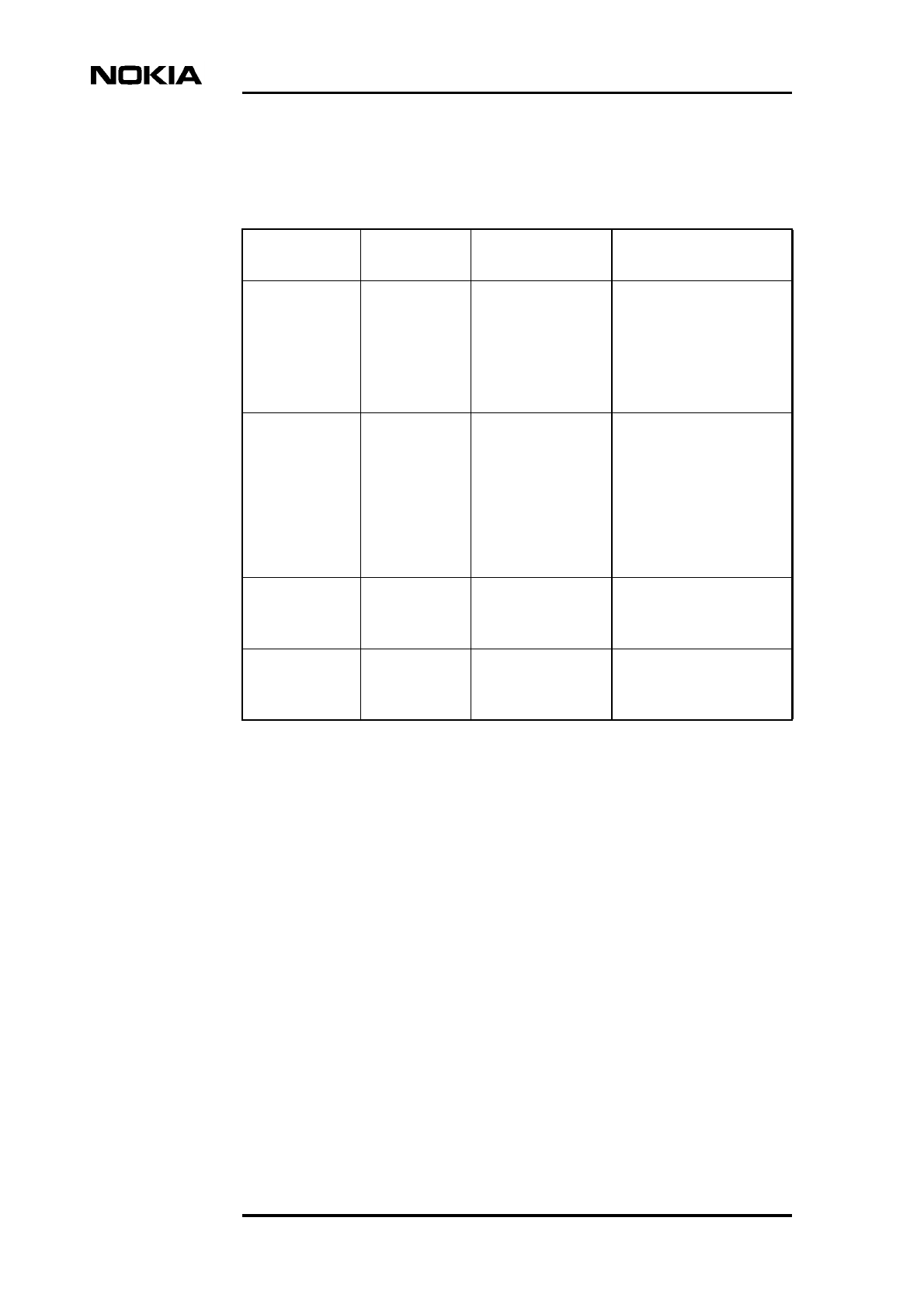
Requirements for Installation and Operation
38 (44) © Nokia Corporation Draft DN9913471
Nokia Proprietary and Confidential Issue 3-0 en
4.1 Cable entry block
The size of the cable entry holes must be considered when planning the cabling
of the Nokia MetroSite EDGE Base Station. The holes can accommodate various
cable diameters, as shown in Figure 8.
Table 8. Transmission connectors of the Nokia MetroSite EDGE Base
Station
Transmission
unit type
Number of
connectors Connector type Cable
FC E1/T1 3 Two coaxial BT43
connectors (75 Ω)
one balanced TQ
connector (100/120
Ω)
Coaxial for 75 Ω
connector
twisted pair for 100/120 Ω
connector.
Max. allowed attenuation
for E1 20 dB; for T1 26 dB
FXC RRI 2 TNC 50 ΩCoaxial Flexbus RG-223
(max. length 140 m),
coaxial Flexbus RG-214
(max. length 300 m).
For more information,
refer to Nokia MetroSite
EDGE Base Station:
Product Description.
FXC E1 75 Ω8 Coaxial BT43
connectors
Coaxial
Max. allowed attenuation
20 dB
FXC E1/T1
120/100 Ω
version
4 Balanced TQ
connectors
Twisted pair
Max. allowed attenuation
for E1 20 dB, for T1 26 dB
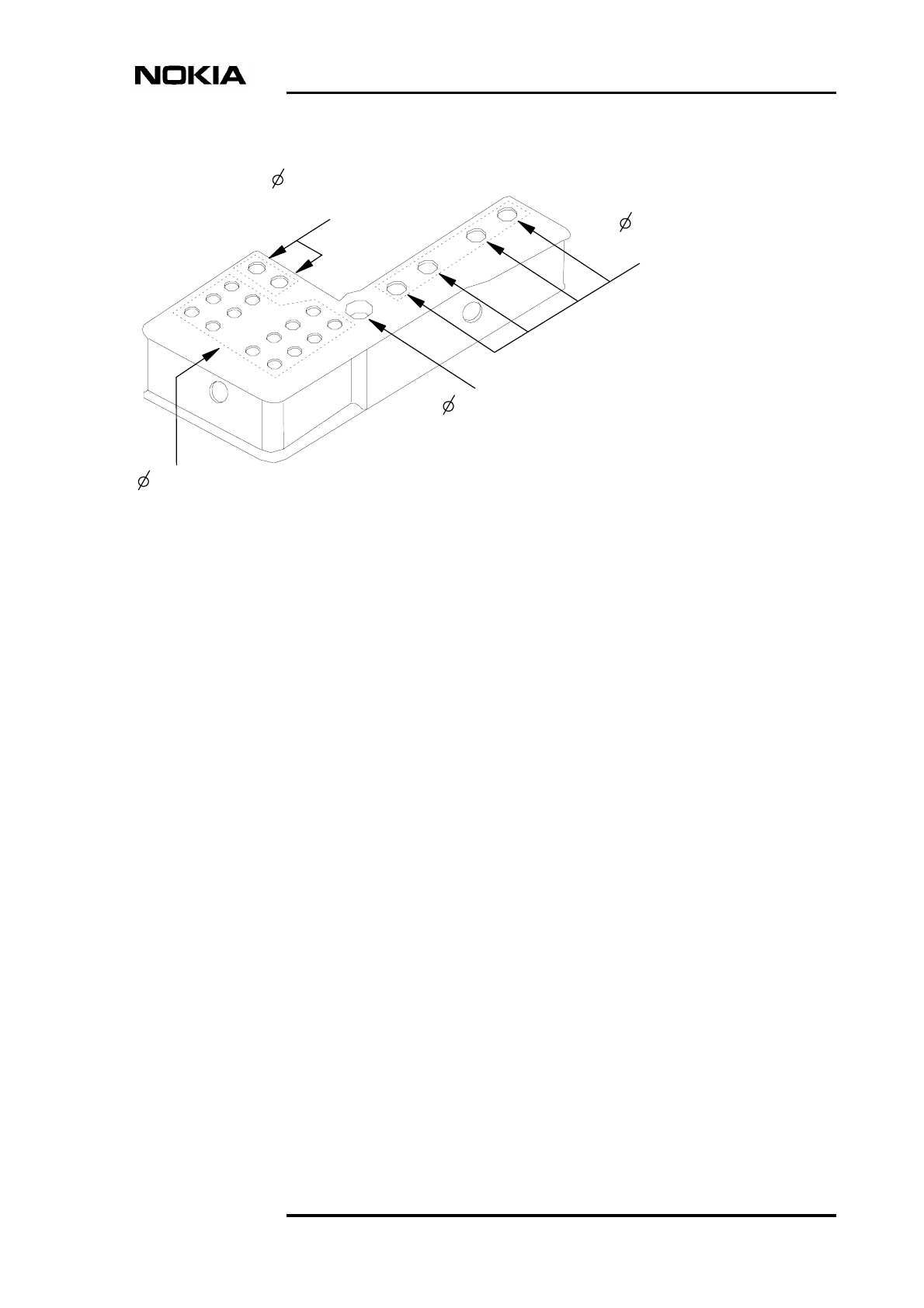
Cabinet interfaces and cables
DN9913471 © Nokia Corporation Draft 39 (44)
Issue 3-0 en Nokia Proprietary and Confidential
Figure 8. Cable entry block: cable diameters
4.5-7 (.18-.28), 14 pcs
7-10 (.28-.39), 2 pcs
10-15 (.39-.59), 1 pc
NOTE: DIMENSIONS mm (inch)
Extension cables
Power supply cable
Antenna feeders
- Grounding cable, 1 pc
- Transmission cables, max 8 pcs
- External alarms and controls
8-12.5 (.31-.49), 4 pcs

Requirements for Installation and Operation
40 (44) © Nokia Corporation Draft DN9913471
Nokia Proprietary and Confidential Issue 3-0 en
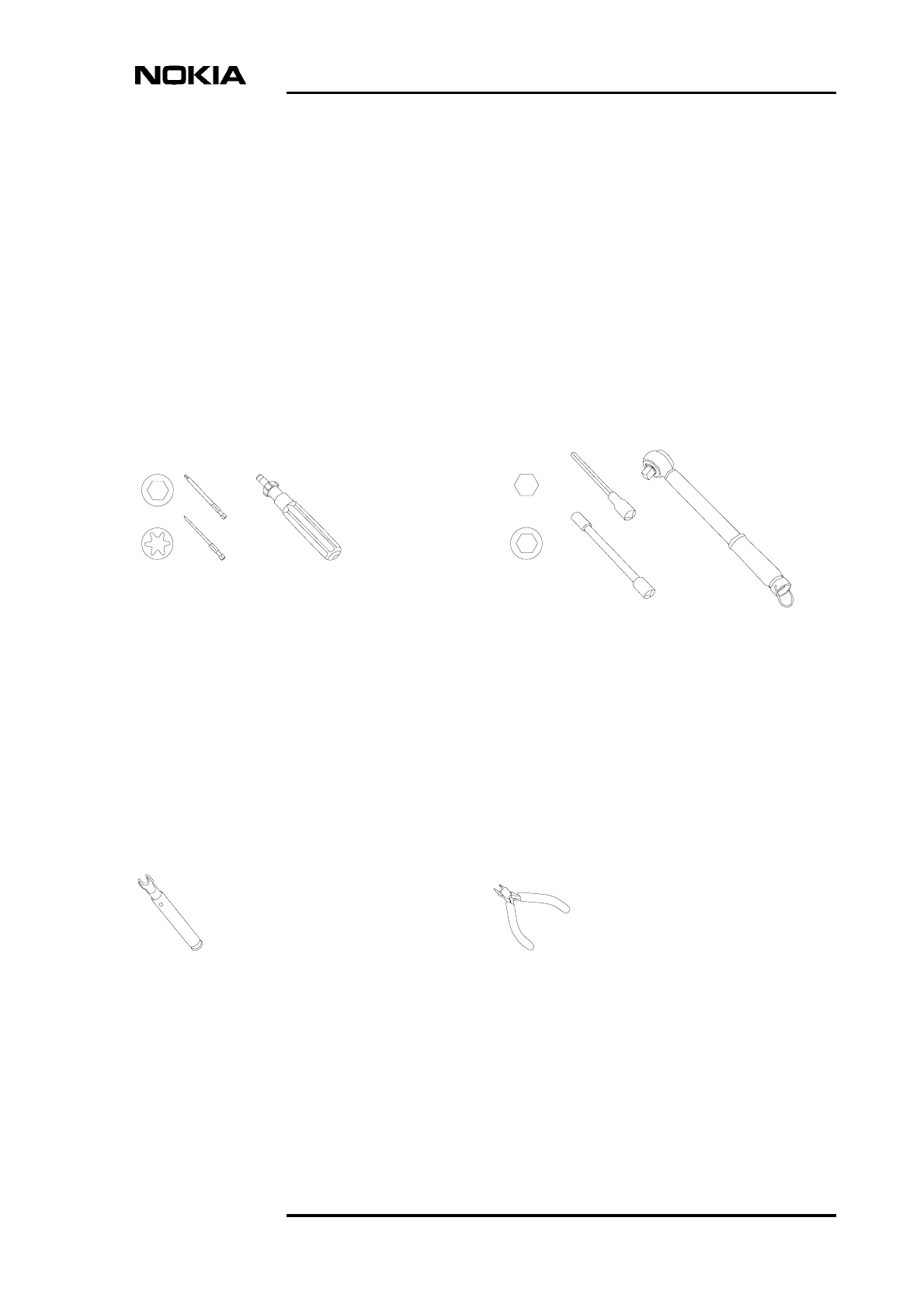
Installation equipment
DN9913471 © Nokia Corporation Draft 41 (44)
Issue 3-0 en Nokia Proprietary and Confidential
5Installation equipment
This section specifies the equipment that is recommended for the installation of
the Nokia MetroSite EDGE Base Station. This equipment is not included in the
BTS delivery.
Figure 9. Recommended tools for installing the BTS
Side-cutting pliers
- for cutting the cable ties
Torque socket spanner/wrench
(5-20 Nm/3-14 ft-lb) with:
- 6 mm Allen bit
A) for bolts of pole bracket
version 1 (12 Nm/8.85 ft-lb)
B) with 80 mm extension for L-beam
offset screws (12 Nm/8.85 ft-lb)
- 8 mm hexagon socket with
min. 80 mm extension
A) for worm screw on pole bracket
version 2 (10 Nm/7.37 ft-lb)
B) for fixing the grounding nut
(5.5 Nm/4.06 ft-lb)
Torque key
- for diversity cables (1 Nm/.74 ft-lb)
Torque driver (0-6 Nm/0-5 ft-lb) with:
- T10 Torx bit with min. 60 mm shaft
for unit retaining screws
(1.5 Nm/1.11 ft-lb)
- 4 mm Allen bit with min. 60 mm shaft:
A) for BTS fixing screws
(5.5 Nm/4.06 ft-lb)
B) for fixing cable entry
block screws
C) for fixing grounding cable
(5.5 Nm/4.06 ft-lb)

Requirements for Installation and Operation
42 (44) © Nokia Corporation Draft DN9913471
Nokia Proprietary and Confidential Issue 3-0 en
Note
Additional equipment includes:
• LMP cable for connecting the manager PC to the BTS
• antistatic wrist strap
• spirit level for checking the horizontal level of the BTS
• tape measure
• cable ties for securing the cable routing out of the BTS
• crimping tool for fitting a crimp terminal to the grounding cable
A set of tools needed for assembling the cable connectors is available from Nokia.
• cable stripper for preparing the grounding cable
• ladder (depending on the installation height from the ground)
• 10 mm spanner for removing the grounding bridge on the transmission unit
(optional)
• T20 Torx torque driver for removing and tightening the BTS cover top
retaining screws (optional)
• centre punch for marking drill hole locations when mounting the BTS on a
wall (optional)

DN9913471 ©Nokia Corporation Draft 43 (44)
Issue 3-0 en Nokia Proprietary and Confidential
Index
A
acoustic noise 19,30
C
cable diameters 37,39
cable protection 31
cables
antenna feeders 38
extension 38
external alarms and controls 38
grounding 38
power supply 38
transmission 38
types 37
checking the site 21
clearances 22
connector types 37
D
diameters, cables 37,39
dimensions
BTS 22
E
electromagnetic compatibility (EMC) shielding 19
environmental conditions
operation 17
storage 13
transportation 15
equipment for installation 41
F
fuses 31
G
grounding 27
grounding cable 27
grounding conductor 27
grounding points 27
I
ingress protection 19
installation
requirements for 21
installation equipment 41
installation space 21
interface connectors 37
M
mains power 28
mounting
locations 24
positions 24
requirements for 26
O
operation
climatic conditions 17
international standard for 17
mechanical conditions 19
safety requirements for 19
P
packing cardboard 24
painting the BTS cover 33
power consumption 28
power supply options 28
R
requirements for installation 21
S
site survey 21
space requirements 21
stand-by mode 28
storage
climatic conditions 13
international standard for 13
mechanical conditions 14
T
The cable entry block is made of a flexible
material.cable entry block 38
tools 41
transportation
climatic conditions 15
international standard for 15
mechanical conditions 17
